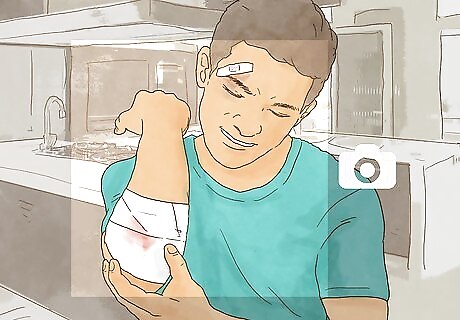
views
Gathering Evidence
Talk to your insurance company. Depending on your claim or case, your insurance company may be able to provide you with an attorney or legal team to help. Your insurance company may even do all of the negotiations for you with the defendant or their insurance company. Before you do anything, it's a good idea to reach out to your insurance company to see if they can help. Keep in mind that your insurance company may just pay you directly without a settlement depending on your policy.

Consult with an attorney. Some lawsuits are simple, and you can handle them on your own. However, other cases are complex and you might need to hire a lawyer. In any event, you should consult with an attorney to talk about your case. Ask friends or family if they can recommend someone. If you have no leads, then get a referral from your nearest bar association. Call and schedule a consultation where you can talk about your case. The lawyer can give you good advice about how complicated the case will be and whether you should even sue. Generally, you can hire a lawyer in a personal injury lawsuit or discrimination lawsuit without having to pay fees. Instead, the lawyer will represent you on contingency, meaning they only get paid if you win.

Write down what you remember. You are a party to the lawsuit, so sit down as soon as possible and record your memories. What happened? When did it happen? Try to be as detailed as possible. As time passes, you’ll remember less, so get it all down now.

Identify witnesses. You’ll want them to testify on your behalf at trial. Identify any witnesses and take down their name, contact information, and a brief description of what they saw. If you are badly injured, ask someone else to take down this information before everyone leaves the scene of the accident. You can also ask witnesses to submit affidavits, which are sworn and written testimonies of what they witnessed. If you’re suing an employer for discrimination, good witnesses include fellow employees and your boss. If you’re suing for a personal injury, then a good witness is anyone who saw you get injured.

Take pictures. If you were injured at a store, have someone return to the store to take pictures of any hazard that injured you. You should also take pictures of your injuries while they are fresh. By the time you get to trial, bruises will disappear and scars will heal. Make sure the time stamp works on your camera and that it records the proper date. If not, write the date down on the back of developed pictures. Take photographs from many different angles and different light. Remember not to smile in your photographs.

Gather medical records. If you suffered a physical injury, you’ll need medical documentation. Get copies of emergency room admitting charts, doctors’ notes, test and exam results, as well as your doctor’s diagnosis and prognosis. Also write down a list of medicines you have taken. Hold onto all medical bills, since you can be reimbursed for them. If you hire an attorney, they may recommend that you visit a doctor that specializes in personal injury cases. However, if you need emergency medical treatment, don't wait for a referral from your attorney.

Collect proof of other injuries. You can sue for a variety of injuries, depending on the circumstances. Consider the following: Pain and suffering. Document this suffering in a pain journal. Each day, write down how you are feeling and the location and intensity of any pain. Lost wages. The injury might have prevented you from working. Gather evidence of how much you made, e.g., recent pay stubs or proof of self-employed income. You can be compensated for this loss.

Avoid delay. You only have a limited amount of time to bring a lawsuit. This window of time is called the “statute of limitations.” Search online or ask a lawyer about the statute of limitations for your claim. If you wait too long, you can’t bring a lawsuit, no matter how solid your case. Some statutes of limitations are only a year, so don’t delay.

Send a written demand to the company. In some states, you need to send a demand letter to the defendant before you can sue. In the letter, you explain your injuries and tell the defendant how much you are willing to settle for. Set the amount high—you should expect the defendant to try and negotiate the amount down. Hold onto a copy of your letter before mailing it certified mail, return receipt requested.
Choosing Where to Sue

Sue in small claims court if your case is small. In the U.S., each state has a small claims court that handles smaller matters. These courts are ideal, especially if you don’t have a lawyer. Each state has a maximum limit that you can sue for in the court. For example, in Alabama, the limit is $6,000, but in Alaska the limit is $10,000. You can search online to find out the limit in your state, or stop into your court and ask the clerk for the dollar limit.

Identify where the defendant does business. You can only sue in a court that has power over a defendant. This power is called “jurisdiction.” Usually, you can sue in the jurisdiction where the defendant does business. If the company has an office in the state, you can typically sue them there. There are exceptions, like if a company was traveling through a state they usually don't do business in when the injury occurred. In that case, the courts in that state would have jurisdiction over them. For example, you might live in Missouri but go to Florida for vacation. While on vacation, you go shopping and get injured at a store. If the company has stores in Missouri, you can probably sue back home. However, if the company only has stores in Florida, chances are you can’t sue in your home state.

Choose whether to sue in state or federal court. If you don’t want to sue in small claims court, you should decide which regular civil court to sue in. In the U.S., you sometimes have a choice whether to sue in state or federal court. Consider the following factors: To sue in federal court, your case should arise under federal law. For example, federal antidiscrimination law allows you to sue in federal court. Alternately, you can sue in federal court if you reside in a different state from where the defendant has its principal place of business. The case must also be worth a certain amount (more than $75,000 as of 2017). This is called diversity jurisdiction. In this situation, you can bring your case in federal court even though you are suing under state law, not federal law. Often, you have a choice. For example, you can bring most federal law cases in state court.
Filing Your Legal Papers

Learn the law. You can only sue if you have a recognizable “cause of action.” There are many causes of action, but each has certain elements or facts you must prove in order to win. You should identify your causes of action ahead of time. An easy way to learn about the law is to find pattern jury instructions online. Common causes of action include the following: Negligence. This means someone injured you because they were careless. You must prove the defendant owed you a duty of reasonable care, that they broke that duty, and that their carelessness caused your injuries. A common example: car accidents. Breach of contract. You must show that you have a valid contract, that the company broke the terms of the contract, and that you suffered injury. Employment discrimination. Employment discrimination involves an adverse employment action (such as demotion or termination) taken because of your protected characteristic, such as your race, color, religion, sex, age, national origin, disability, or genetic information. Fraud. Fraud occurs when the defendant creates a false impression that you relied on, and you suffered injury as a result of that reliance. A common example: you bought a house because the owner said the roof was new when it wasn’t.

Fill out your complaint. You start a lawsuit by filing a complaint in which you identify yourself as the “plaintiff” and the company you are suing as the “defendant.” Also explain the factual background to the dispute. You also make a claim for money compensation (called “damages”). Some courts have fill-in-the-blank forms you can use. Check the court’s website or ask the court clerk. If no form is available, then search for sample complaints online or in a book of legal forms which you can find in a library. Alternately, you should consult with an attorney if you need help.

File your complaint with the court clerk. Make copies of your complaint and take the original and copies to the court clerk. Ask to file. Typically, you need to pay a filing fee. Ask for a fee waiver form if you can’t afford it. You’ll also need to fill out a summons at the clerk’s office.

Arrange to serve the defendant’s agent. Serve a copy of the complaint and the summons on the defendant. A company should have a registered agent who will receive service of process. This agent’s name should be listed in your jurisdiction’s business database. Generally, you’ll need to pay someone to serve the papers, either the sheriff or a private process server. If you sue in small claims court, you can usually mail the papers to the defendant.

Read the defendant’s response. The defendant should file an answer in which they deny your allegations and even counter-sue you. For example, if you sue for breach of contract, it’s common for the defendant to claim you really broke the contract. If you sue a large company, you might have agreed to arbitrate any disputes instead of going to trial. Look at any contract you signed with the company. These arbitration clauses are enforceable, and the defendant will ask the judge to compel arbitration.
Preparing for Trial

Consider settlement or mediation. Lawsuits are time-consuming, unpredictable, and expensive. For these reasons, you might want to settle your case before going to court. Often, both sides are happy with a settlement. You’ll get some money to compensate you for your injuries, and the company can put this dispute behind them. Mediation is useful if you don’t have a lawyer, since it is a form of guided settlement. You and the defendant meet with a mediator, who helps each side listen to the other. If you are successful, you sign a settlement agreement and dismiss your lawsuit.

Subpoena your witnesses. Draw up a list of witnesses who have helpful information. You’ll need to give the defense a witness list. You also need to make sure witnesses show up at trial, so serve them a subpoena. There should be a form you can fill out at the clerk’s office.

Continue on to trial. Each trial is a little different. If you are in small claims court, then you probably won’t have a jury. Instead, a judge will hear the case. The process might be informal, or not—each state sets its own rules. A trial in civil court will be more formal. Each side will make opening statements and closing arguments. As the plaintiff, you will call your witnesses first and then cross-examine the defense witnesses. The best way to learn about a trial is to sit in on one. Courthouses are open to the public, so find a trial that has just started. Sit in the back and take notes. Pay attention to where the parties sit and stand, and the kinds of questions they ask witnesses.




















Comments
0 comment